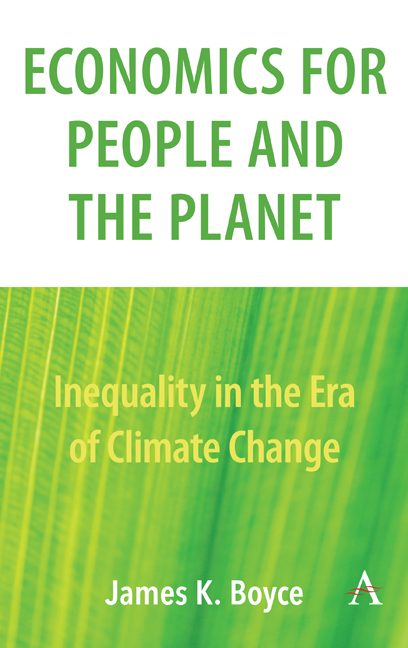Book contents
- Frontmatter
- Contents
- List of Illustrations
- Acknowledgements
- Part I Rethinking Economics and the Environment
- Part II Environmental Injustice
- Part III Climate Policy
- Chapter 17 Smart Climate Policy
- Chapter 18 Investment in Disadvantaged Communities
- Chapter 19 Dividends for All
- Chapter 20 Truth Spill
- Chapter 21 Four Pillars of Climate Justice
- Chapter 22 The Perverse Logic of Offsets
- Chapter 23 Climate Policy as Wealth Creation
- Chapter 24 The Carbon Dividend
- Chapter 25 Keeping the Government Whole
- Chapter 26 Air Quality Co-benefits in Climate Policy
- Chapter 27 Climate Adaptation: Protecting Money or People?
- Chapter 28 Forging a Sustainable Climate Policy
- Notes
- Publication History
- Index
Chapter 19 - Dividends for All
from Part III - Climate Policy
Published online by Cambridge University Press: 12 February 2019
- Frontmatter
- Contents
- List of Illustrations
- Acknowledgements
- Part I Rethinking Economics and the Environment
- Part II Environmental Injustice
- Part III Climate Policy
- Chapter 17 Smart Climate Policy
- Chapter 18 Investment in Disadvantaged Communities
- Chapter 19 Dividends for All
- Chapter 20 Truth Spill
- Chapter 21 Four Pillars of Climate Justice
- Chapter 22 The Perverse Logic of Offsets
- Chapter 23 Climate Policy as Wealth Creation
- Chapter 24 The Carbon Dividend
- Chapter 25 Keeping the Government Whole
- Chapter 26 Air Quality Co-benefits in Climate Policy
- Chapter 27 Climate Adaptation: Protecting Money or People?
- Chapter 28 Forging a Sustainable Climate Policy
- Notes
- Publication History
- Index
Summary
California can use carbon revenues to build durable public support for its pioneering effort to wean the state's economy from fossil fuels. Based on a memorandum written for the Economics and Allocation Advisory Committee (EAAC) of the California Air Resources Board and California Environmental Protection Agency.
The return of carbon permit auction revenues as equal per capita dividends to the public is sometimes termed ‘cap-and-dividend’. This policy option was singled out in Governor Schwarzenegger's 22 May 2009 letter to the EAAC:
There is one idea in particular I would like you to explore among other options: the concept of returning the value of allowances back to the people, including through an auction of allowances and distribution of auction proceeds in the form of a rebate or dividend.
There are three fundamental rationales for cap-and-dividend.
The principle of common ownership of nature's wealth: A consequence of any policy to limit use of a resource–to manage scarcity–is the creation of property rights. Cap-and-dividend starts from the premise that rights to the property created by the introduction of carbon permits belong in common and equal measure to all. Cap-and-dividend is a ‘feebate’ arrangement in which individuals pay fees based on their use of a scarce resource that they own in common, and the fees are then rebated in equal measure to all co-owners. In this case, the scarce resource is the California's share of the carbon storage capacity of the atmosphere; the fee is set by the carbon footprint of each household; and the co-owners are the people of the state.
Protection of household real incomes: A second rationale is to protect the real incomes of households from the impact of higher fossil fuel prices resulting from the cap. If the amount paid by households in higher prices is returned as dividends, the household sector as a whole is made whole by the policy. The net impact on any individual household varies depending on its carbon footprint. Those with larger-than-average carbon footprints pay more than they receive in dividends; those with smaller-than-average carbon footprints receive more than they pay. Since carbon footprints are correlated with income, lower-income and middle-income families generally receive greater net benefits from the policy than upper-income households.
- Type
- Chapter
- Information
- Economics for People and the PlanetInequality in the Era of Climate Change, pp. 95 - 102Publisher: Anthem PressPrint publication year: 2019



